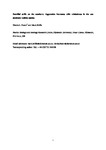Familial strife on the seashore: Aggression increases with relatedness in the sea anemone Actinia equina
| dc.contributor.author | Foster, Nicola | |
| dc.contributor.author | Briffa, Mark | |
| dc.date.accessioned | 2015-10-21T13:44:12Z | |
| dc.date.accessioned | 2015-10-21T13:44:57Z | |
| dc.date.available | 2015-10-21T13:44:12Z | |
| dc.date.available | 2015-10-21T13:44:57Z | |
| dc.date.issued | 2014-03 | |
| dc.identifier.issn | 0376-6357 | |
| dc.identifier.issn | 1872-8308 | |
| dc.identifier.uri | http://hdl.handle.net/10026.1/3690 | |
| dc.description.abstract |
Pairwise contests occur when two individuals compete directly over ownership of an indivisible resource. Contests vary in the degree of escalation, some encounters being settled through non-injurious behaviour while others are only resolved after dangerous fighting. Here, we investigate the role of relatedness, assessed using AFLP analysis, on the occurrence of stinging during staged contests in the beadlet sea anemone Actinia equina. Contrary to our expectations, we found that the chance of stinging, and hence the chance of inflicting damage, increased with the degree of relatedness between the two opponents. This result may be explained by the negative relationship between asymmetry in fighting ability and escalation level predicted by theory. We suggest that in order to fully understand how relatedness influences aggression, predictions from kin selection theory should be incorporated with those from contest theory. | |
| dc.format.extent | 243-245 | |
| dc.format.medium | Print-Electronic | |
| dc.language | en | |
| dc.language.iso | eng | |
| dc.publisher | Elsevier BV | |
| dc.relation.replaces | http://hdl.handle.net/10026.1/3689 | |
| dc.relation.replaces | 10026.1/3689 | |
| dc.subject | Actinia equina | |
| dc.subject | AFLP | |
| dc.subject | Aggression | |
| dc.subject | Contest | |
| dc.subject | Relatedness | |
| dc.title | Familial strife on the seashore: Aggression increases with relatedness in the sea anemone Actinia equina | |
| dc.type | journal-article | |
| dc.type | Journal Article | |
| plymouth.author-url | https://www.webofscience.com/api/gateway?GWVersion=2&SrcApp=PARTNER_APP&SrcAuth=LinksAMR&KeyUT=WOS:000335624900035&DestLinkType=FullRecord&DestApp=ALL_WOS&UsrCustomerID=11bb513d99f797142bcfeffcc58ea008 | |
| plymouth.volume | 103 | |
| plymouth.publication-status | Published | |
| plymouth.journal | Behavioural Processes | |
| dc.identifier.doi | 10.1016/j.beproc.2014.01.009 | |
| plymouth.organisational-group | /Plymouth | |
| plymouth.organisational-group | /Plymouth/Faculty of Science and Engineering | |
| plymouth.organisational-group | /Plymouth/Faculty of Science and Engineering/School of Biological and Marine Sciences | |
| plymouth.organisational-group | /Plymouth/REF 2021 Researchers by UoA | |
| plymouth.organisational-group | /Plymouth/REF 2021 Researchers by UoA/UoA04 Psychology, Psychiatry and Neuroscience | |
| plymouth.organisational-group | /Plymouth/REF 2021 Researchers by UoA/UoA07 Earth Systems and Environmental Sciences | |
| plymouth.organisational-group | /Plymouth/Research Groups | |
| plymouth.organisational-group | /Plymouth/Research Groups/Marine Institute | |
| plymouth.organisational-group | /Plymouth/Users by role | |
| plymouth.organisational-group | /Plymouth/Users by role/Academics | |
| plymouth.organisational-group | /Plymouth/Users by role/Researchers in ResearchFish submission | |
| dc.publisher.place | Netherlands | |
| dcterms.dateAccepted | 2014-01-14 | |
| dc.identifier.eissn | 1872-8308 | |
| dc.rights.embargoperiod | Not known | |
| rioxxterms.versionofrecord | 10.1016/j.beproc.2014.01.009 | |
| rioxxterms.licenseref.uri | http://www.rioxx.net/licenses/all-rights-reserved | |
| rioxxterms.licenseref.startdate | 2014-03 | |
| rioxxterms.type | Journal Article/Review |


